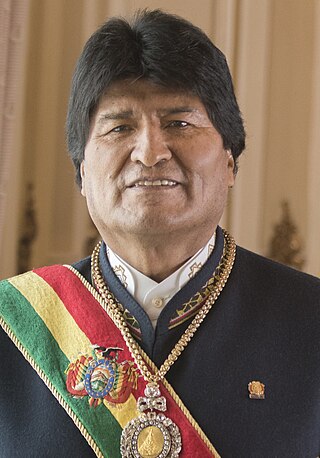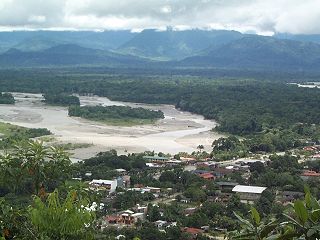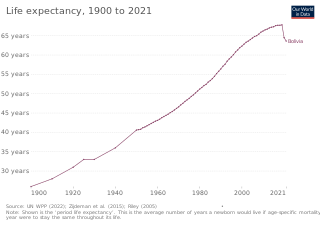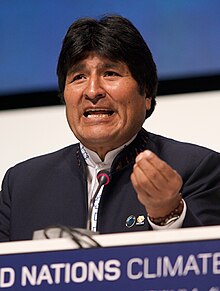
Coca is any of the four cultivated plants in the family Erythroxylaceae, native to western South America. Coca is known worldwide for its psychoactive alkaloid, cocaine.

Coca eradication is a strategy promoted by the United States government starting in 1961 as part of its "war on drugs" to eliminate the cultivation of coca, a plant whose leaves are not only traditionally used by indigenous cultures but also, in modern society, in the manufacture of cocaine. The strategy was adopted in place of running educational campaigns against drug usage. The prohibitionist strategy is being pursued in the coca-growing regions of Colombia, Peru, and formerly Bolivia, where it is highly controversial because of its environmental, health and socioeconomic impact. Furthermore, indigenous cultures living in the Altiplano, such as the Aymaras, use the coca leaf in many of their cultural traditions, notably for its medicinal qualities in alleviating the feeling of hunger, fatigue and headaches symptomatic of altitude sicknesses. The growers of coca are named Cocaleros and part of the coca production for traditional use is legal in Peru, Bolivia and Chile.

Juan Evo Morales Ayma is a Bolivian politician, trade union organizer, and former cocalero activist who served as the 65th president of Bolivia from 2006 to 2019. Widely regarded as the country's first president to come from its indigenous population, his administration worked towards the implementation of left-wing policies, focusing on the legal protections and socioeconomic conditions of Bolivia's previously marginalized indigenous population and combating the political influence of the United States and resource-extracting multinational corporations. Ideologically a socialist, he has led the Movement for Socialism (MAS) party since 1998.

Chapare (Spanish:[tʃaˈpaɾe], also called The Chapare, is a rural province in the northern region of Cochabamba Department in central Bolivia. Most of the territory consists of valley rainforests that surround the area's main waterway, the Chapare River, which is also a tributary of the Amazon River. The provincial capital is Sacaba, 11 km east of Cochabamba. Its principal town is Villa Tunari, a popular tourist destination.

Felipe Quispe Huanca "Mallku", was a Bolivian historian and political leader. He headed the Pachakuti Indigenous Movement (MIP) and was general secretary of the United Union Confederation of Working Peasants of Bolivia (CSUTCB).

Movement for Socialism – Political Instrument for the Sovereignty of the Peoples, is a socialist political party in Bolivia. Its followers are known as Masistas. In the December 2005 election, MAS-IPSP won the first ever majority victory by a single Bolivian party. The party continued to rule until 10 November 2019, and was victorious again in the 2020 elections.

Sacaba is a capital city and a municipality in the Bolivian province of Chapare. The city, located 13 kilometers eastward from Cochabamba, is the second largest city in the Cochabamba Department after Cochabamba city. Post-colonial architecture may be seen in the inner part of Sacaba; however, some has been destroyed due to lack of municipal care.

Bolivia–United States relations were established in 1837 with the first ambassadorial visit from the United States to Peru–Bolivian Confederation. The Confederation dissolved in 1839, and bilateral relations did not occur until 1848 when the United States recognized Bolivia as a sovereign state and appointed John Appleton as the Chargé d'Affaires.

In terms of key indicators, health in Bolivia ranks nearly last among the Western Hemisphere countries. Only Haiti scores consistently lower. Bolivia's child mortality rate of 69 per 1,000 live births is the worst in South America. Proper nourishment is a constant struggle for many Bolivians. Experts estimate that 7 percent of Bolivian children under the age of five and 23 percent of the entire population suffer from malnutrition. Another health factor in Bolivia is sanitation.

The domestic policy of the Evo Morales administration refers to the domestic policy initiatives of the former President of Bolivia, including past pre-presidential advocacies by Morales.
In 2012, coca production in Colombia amounted to 0.2% of Colombia's overall GDP and 3% of Colombia's GDP related to the agricultural sector. The great majority of coca cultivation takes place in the departments of Putumayo, Caquetá, Meta, Guaviare, Nariño, Antioquia, and Vichada.

The history of Bolivia since 1982 begins with the restorations of democracy after the rule of the military junta of 1982. Evo Morales held the presidency from 2006 to 2019. A new constitution was enacted in 2009. Bolivia's population has roughly doubled over this period, from 5 million in 1980 to 10 million as of 2012.
Coca Colla is an energy drink produced in Bolivia with the use of coca extract as its base. It was launched on the Bolivian market in La Paz, Santa Cruz and Cochabamba in April 2010. Both the name and ingredients are similar to Coca-Cola. The release of this product is part of the process of the industrialization of coca followed by the Morales Administration from 2006 to 2019. The "Colla" component of the name comes from Qullasuyu, the southern area of the Inca empire which included the western part of Bolivia. The term Qulla is nowadays used to name the Aymara and Quechua, indigenous people of Bolivia who make a traditional use of coca leaves.
The Villa Tunari Massacre was a 27 June 1988 mass murder committed by UMOPAR troops in response to a protest by coca-growing peasants (cocaleros) in the town of Villa Tunari in Chapare Province, Bolivia. The cocalero movement had mobilized since late May 1988 in opposition to coca eradication under Law 1008, then on the verge of becoming law. According to video evidence and a joint church-labor investigative commission, UMOPAR opened fired on unarmed protesters, at least two of whom were fatally shot, and many of whom fled to their deaths over a steep drop into the San Mateo River. The police violence caused the deaths of 9 to 12 civilian protesters, including three whose bodies were never found, and injured over a hundred. The killings were followed by further state violence in Villa Tunari, Sinahota, Ivirgarzama, and elsewhere in the region, including machine gun fire, beatings, and arrests.
Narcotics in Bolivia, South America, is a subject that primarily involves the coca crop, used in the production of the drug, cocaine. Trafficking and corruption have been two of the most prominent negative side-effects of the illicit narcotics trade in Bolivia and the country's government has engaged in negotiations with the United States (US) as result of the industry's ramifications.

Coca has been cultivated in medium-altitude parts of the Bolivian Andes since at least the Inca era, primarily in the Yungas north and east of La Paz. Cultivation expanded substantially in the 1980s into the Chapare region of Cochabamba and some production flowed into the international cocaine market. The US-backed efforts to criminalize and eradicate coca as part of the War on Drugs were met by the cocalero movement's growing capacity to organize. Violence between drug police and the Bolivian armed forces on one side and the movement on the other occurred episodically between 1987 and 2003. The cocaleros became an increasingly important political force during this period, co-founding the Movement for Socialism – Political Instrument for the Sovereignty of the Peoples party. Coca growers from both the Yungas and the Chapare have advocated for policies of "social control" over coca growing, maintaining a pre-set maximum area of cultivation as an alternative to drug war policies. In 2005, cocalero union leader Evo Morales was elected president of Bolivia. Morales has pursued a combined policy of legalizing coca production in the Chapare and Yungas and eradication of the crop elsewhere.

Indigenous peoples in Bolivia, or Native Bolivians, are Bolivian people who are of indigenous ancestry. They constitute anywhere from 20 to 60% of Bolivia's population of 11,306,341, depending on different estimates, and depending notably on the choice "Mestizo" being available as an answer in a given census, in which case the majority of the population identify as mestizo, and they belong to 36 recognized ethnic groups. Aymara and Quechua are the largest groups. The geography of Bolivia includes the Andes, the Gran Chaco, and the Amazon Rainforest.
The Chapare Drug Cartel is a Bolivian criminal organization dedicated to drug trafficking and human trafficking that operates in the Chapare region. For this, several journalists have baptized this organization simply as the Chapare Cartel

Andrónico Rodríguez Ledezma is a Bolivian cocalero activist, political scientist, politician, and trade unionist serving as president of the Senate since 2020. A member of the Movement for Socialism, he serves as senator for Cochabamba. Rodríguez's lengthy career in the cocalero union hierarchy saw him serve as general secretary of the 21 September Workers' Center from 2015 to 2016 and as executive of the Mamoré Bulo Bulo Federation from 2016 to 2018, in addition to a multitude of other minor positions. He has served as vice president of the Coordination Committee of the Six Federations of the Tropic of Cochabamba since 2018 and held office as president of the organization from 2019 to 2020 in the absence of the body's longtime leader, Evo Morales.

Tito Veizaga Cossío is a Bolivian cocalero activist, politician, and trade unionist who served as a member of the Chamber of Deputies from La Paz, representing circumscription 17 from 2015 to 2020. A member of the Movement for Socialism, Veizaga followed the usual path taken by rural union leaders, scaling the ranks of trade syndicate leadership until reaching the departmental level. In 2004, he was elected to serve as mayor of Cajuata, and though he failed in his attempt at reelection in 2010, he maintained a presence in his party's internal structure. In 2014, Veizaga was elected to represent the Yungas region in the Chamber of Deputies. Though many local cocaleros opposed the government's attempt at regulating their crop, Veizaga held the party line, supporting the passage of the 2017 General Law of Coca. He was not nominated for reelection.
















